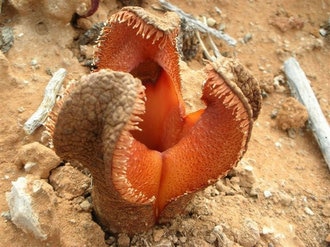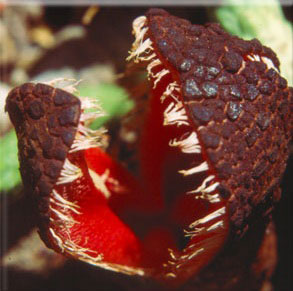This is a Skunk Cabbage plant. The reason it has this name is pretty simple, it gives off a foul odor, often mistaken for the odor of a skunk. The weird thing is that it uses this smell to attract bugs. I think that is pretty cool because I've heard of bugs being attracted to plants because of color, but not by smell! Another weird fact, stated near the end of the video, is that this plant can be used for cooking! How can a skunk-like smelling plant be used to make food? For more information, watch the video shown above.
Thursday, 28 November 2013
Skunk Cabbage Plant
This is a Skunk Cabbage plant. The reason it has this name is pretty simple, it gives off a foul odor, often mistaken for the odor of a skunk. The weird thing is that it uses this smell to attract bugs. I think that is pretty cool because I've heard of bugs being attracted to plants because of color, but not by smell! Another weird fact, stated near the end of the video, is that this plant can be used for cooking! How can a skunk-like smelling plant be used to make food? For more information, watch the video shown above.
Wednesday, 27 November 2013
Extreme Plant


This scary-looking plant is called the Hydnora Africana. It looks a lot like a venus fly-trap plant, but even worse! This plant smells like dung because one of its favorite visitors is the dung beetle. Eventually the dung beetle crawls into this plant's jaw-like leaves, and then, rather than eat the beetle, it instead traps the beetle alive for a short period of time. The Hydnora Africana's goal is for the beetle to lose bodily fluids so the fluids can pollinate it. After being pollinated the plant opens its mouth, letting the beetle go.
Pinecones and Acorns
The main difference between pinecones and acorns is that pinecones have seeds and acorns do not. Pinecones come from coniferous pine trees (coniferous meaning cone bearing) and acorns come from deciduous oak trees. Acorns are dispersed because of all the animals that eat them. Either they are eaten and later expelled from the animal when it goes to toilet, after which they grow, or when squirrels bury their acorns they often forget one or two, so then the acorns grow there. Pinecones disperse themselves by dispersing their seeds (pollen) using the wind. One thing similar between pinecones and acorns is that they both grow on trees.
Tuesday, 26 November 2013
Monday, 25 November 2013
Thursday, 21 November 2013
Plant Parts Under A Microscope
This is a general cross section of a root of a vascular plant, shown under a microscope on medium power (100x). The major functions of roots are to absorb water and nutrients, anchor the plant body to the ground, and store food and nutrients. The xylem and phloem, tube-like structures, help the roots to distribute the water and nutrients throughout the plant, and to all the cells high above ground.
This is a general cross section of a stem of a vascular plant, shown under a microscope on low power (40x). The major functions of stems is to provide support for the plant, and stems also connect the leaves to the roots so that the water and nutrients can be transported from the roots, through the stem, and into the leaves. Woody and herbaceous stems are different because woody stems are hard, and they grow taller and bigger. Some plants with woody stems are shrubs and your average tree. Herbaceous stems are much softer and plants with these stems are usually short and small. This is because these stems don't grow additional tissues, like woody stems. Plants with herbaceous stems consist of herbs, crops, broccoli, generally your basic backyard garden plants.

This is a general cross section of a leaf of a vascular plant, shown under a microscope on high power (400x). The major functions of leaves are to obtain gas exchange, and sunlight for photosynthesis. Also, they help the plant to respire, and they store food material. The chemical reaction for photosynthesis occurs when the plant obtains carbon dioxide, water, and light. Using these things the plant produces oxygen, sugar, and water. Stomata are important to plants because plants mainly lose their water through these spaces, which allows transpiration. Also, stomata let carbon dioxide through for photosynthesis, which is why stomata are important to us too, because since they let carbon dioxide through, photosynthesis occurs, which means we get more oxygen.
Tuesday, 12 November 2013
Midterm Evaluation
During this term in Biology 11, I learned many things about the different topics that we talked about. Here is evidence of my learning about the topic of:
Classification:
My Classification Project:
I chose this as evidence because it was a pretty big assignment and I think I did well on it, so it shows my understanding of classification well.
My Classification Quiz:
I chose this as evidence because it is the final thing for the classification unit and i got 100% on it! This clearly shows that I understood this unit well.
Taxonomy:
My Scientific Names blog post:
http://shanvirsblog.blogspot.ca/2013/09/scientific-names.html
I chose this blog post as evidence because it shows that I know the different categories of taxonomy (Kingdom, Phylum, Class, Order, Family, Genus, Species), and your comment on this blog post proves that I did good on it.
Evolution:
My Adaptation and Speciation Poster:
I chose this project as evidence because it was a big and quite difficult project, but I still managed to get 100% on it. I believe this is a good example for evidence of my learning in this subject.
Viruses:
My Viruses- Part 1 blog post:
http://shanvirsblog.blogspot.ca/2013/10/viruses-part-1.html
I chose this as evidence because in this post I talk about viruses a lot, and it shows that I know a lot about them.
My Viruses Quiz:
I chose this as evidence because it is a big part of the viruses unit, and I did really good on it, so it is a good piece of evidence.
Bacteria:
My Bacteria and Protist Quiz:
I chose this as evidence because it is a big part of bacteria and I got 100% on it.
My Types of Bacteria and Organelle Functions blog post:
http://shanvirsblog.blogspot.ca/2013/10/types-of-bacteria-and-organelle.html
I chose this as evidence because in this post is displayed most of what I know about bacteria. It really helps to show what I learned.
Protists:
My Bacteria and Protist Quiz:
I chose this as evidence because it is the final assessment of the protist unit, and I did well on this quiz.
In this course I have completed all the given assignments properly, and on time. My level of assignment completion is very good. Every single required blog post is on my blog too. I even did extra posts with pictures from our labs. Personally, I think my overall quality of work is very good.
My most powerful learning experience so far in Biology 11 was when people were sharing their weird, unique animals that they researched. That was really cool.
Now, as for my grade, I think I deserve a high A, somewhere around 97%, preferably more, because I did every single assignment required for this class, handed it in on time, I did every blog post along with extras, and I did exceptionally well on everything we've done. For example, all my projects and quizzes. My blog posts are well done too.
Classification:
My Classification Project:
I chose this as evidence because it was a pretty big assignment and I think I did well on it, so it shows my understanding of classification well.
My Classification Quiz:
I chose this as evidence because it is the final thing for the classification unit and i got 100% on it! This clearly shows that I understood this unit well.
Taxonomy:
My Scientific Names blog post:
http://shanvirsblog.blogspot.ca/2013/09/scientific-names.html
I chose this blog post as evidence because it shows that I know the different categories of taxonomy (Kingdom, Phylum, Class, Order, Family, Genus, Species), and your comment on this blog post proves that I did good on it.
Evolution:
My Adaptation and Speciation Poster:
I chose this project as evidence because it was a big and quite difficult project, but I still managed to get 100% on it. I believe this is a good example for evidence of my learning in this subject.
Viruses:
My Viruses- Part 1 blog post:
http://shanvirsblog.blogspot.ca/2013/10/viruses-part-1.html
I chose this as evidence because in this post I talk about viruses a lot, and it shows that I know a lot about them.
My Viruses Quiz:
I chose this as evidence because it is a big part of the viruses unit, and I did really good on it, so it is a good piece of evidence.
Bacteria:
My Bacteria and Protist Quiz:
I chose this as evidence because it is a big part of bacteria and I got 100% on it.
My Types of Bacteria and Organelle Functions blog post:
http://shanvirsblog.blogspot.ca/2013/10/types-of-bacteria-and-organelle.html
I chose this as evidence because in this post is displayed most of what I know about bacteria. It really helps to show what I learned.
Protists:
My Bacteria and Protist Quiz:
I chose this as evidence because it is the final assessment of the protist unit, and I did well on this quiz.
In this course I have completed all the given assignments properly, and on time. My level of assignment completion is very good. Every single required blog post is on my blog too. I even did extra posts with pictures from our labs. Personally, I think my overall quality of work is very good.
My most powerful learning experience so far in Biology 11 was when people were sharing their weird, unique animals that they researched. That was really cool.
Now, as for my grade, I think I deserve a high A, somewhere around 97%, preferably more, because I did every single assignment required for this class, handed it in on time, I did every blog post along with extras, and I did exceptionally well on everything we've done. For example, all my projects and quizzes. My blog posts are well done too.
Wednesday, 6 November 2013
Phialella Zappai
A Philella Zappai is a jellyfish that a jellyfish expert named after a famous musician, named Frank Zappa. It was named by Ferdinando "Nando" Boero, a jellyfish expert from Genova, Italy. He named it after this musician simply because he admired him and he wanted to meet him. When Frank found out about this, he said, “There is nothing I would like better than having a jellyfish with my name,” Then he invited Ferdinando to his house to spend a couple days with him.
Links:
http://blogs.static.mentalfloss.com/blogs/archives/25388.html
http://en.wikipedia.org/wiki/Phialella_zappai
Subscribe to:
Comments (Atom)














